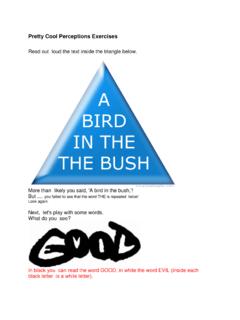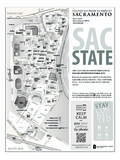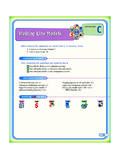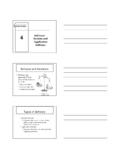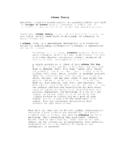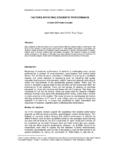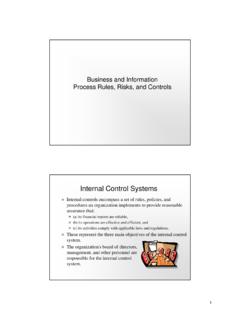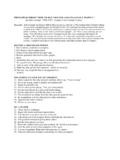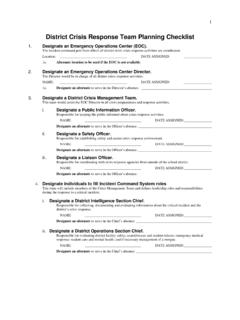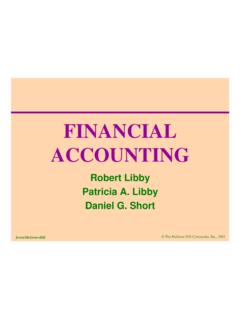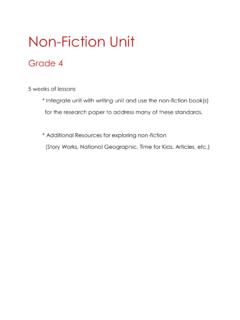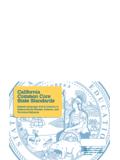Transcription of EXPECTATIONS FOR LESSON PLANS AND OBSERVATIONS …
1 EXPECTATIONS FOR LESSON PLANS AND OBSERVATIONS - STIJDENT TEACHERS Dr. Kathy Moore LESSON PLANS ~ Kindly keep an orderly compilation of all LESSON PLANS that you develop. When I come for the observation, I expect to see all your LESSON PLANS for the courses that you are teaching. These LESSON PLANS will be evaluated according to format and content. Be sure you include your goals and objectives for the semester, unit and daily lessons. ~ LESSON PLANS must be very specific and well developed. Indicate exactly what you plan to do to meet your goals and objectives so that there is evidence of student learning, , what students should know and be able to do when they leave the daily class and complete the course. Write out examples, explanations, short drills, etc. Show your step by step process in the instructional strand. Leave nothing to chance! When the class is over, it should be evident that students have acquired a new skill and enhanced previous learning, skills and understanding of concepts being taught.
2 ~ The LESSON plan must include how much time you expect to spend on each activity. ~ Include copies of all handouts, tests and other materials that you have given to students. I will check these very carefully ~ Kindly provide a copy of your seating chart for each class. I expect to have this by the end of the first week that you are teaching. ON-SITE SUPERVISION VISITS ~ Consult your summary of the EXPECTATIONS and competencies that you must meet. ~ If I arrive and do not receive LESSON PLANS nor observe a well-planned instructional period, the evaluation will be poor. ~ Plan on a conference after each visit to discuss my OBSERVATIONS -commendations and recommendations for improvement. ~ Visits are unannounced. If there is a change in the daily schedule, kindly let me know in advance. Be very aware of changes that occur in the daily schedule at your school site.
3 Shortened class periods will affect your STUDENT TEACHER OBSERVATION CATEGORIES OF MAJOR EMPHASIS IN THE OBSERVATION PROCESS A. CLASSROOM MANAGEMENT --Students on task and engaged in the activity --Mutual respect in evidence --Students aware that the teacher is in control of the class --Classroom rules are obvious and observed; they are posted for quick reference --Students are held accountable for their behavior; there are definite consequences for poor behavior or lack of respect for teacher and classmates B. COMMAND OF THE LANGUAGE - Teacher uses the target language exclusively in class demonstrating strength in communication -- There are no glaring errors in the use ofthe target language --Teacher uses a variety of vocabulary in accord with language level --Teacher is able to manipulate grammatical structures and use idiomatic expressions effectively --Teacher uses target language as the communication tool and requires the same of students --Anything of a written nature (board, overhead, handouts) is perfect; this includes accentuation.
4 C. SEQUENCING OF ACTIVITIES --Goals and objectives of the day's LESSON are clear and in evidence -- The day's agenda is discussed and/or visually represented -- The class is organized around a specific LESSON design fonnat is evidence of in-depth planning where the five language skills are incorporated into every aspect of the LESSON (listening, speaking, reading, writing and culture -- The transitions from activity to activity are clear and orderly. Teacher does not proceed until all students are ready --Students involved in paired activities or cooperative learning groups are closely monitored --Critical thinking on the part of students is evident -- Teacher is obviously well-prepared for the class! --Students are the major panicipants in the LESSON ; the teacher is the facilitator D. COLLABORATIVE LEARNING ACTIVITIES --The LESSON provides opponunities for students to work together --Groups or pairs are randomly selected or are organized according to the dictates of established cooperative learning methods -- Teacher has provided clear instructions and modeled the activity for the groups --Students are under control and are accomplishing the task-not wasting time --Students are closely monitored by teacher --Students are held accountable (oraJly or in written form) for work accomplished in groups/pairs --Teacher is constantly moving around the room observing and facilitating student work acting as guide and resource E.)
5 LESSON PLANS LESSON PLANS are professionaJIy done on computer or neatly hand-written -- Teacher is keeping a notebook of LESSON PLANS -- The concepts to be taught for the year, semester (6 or 7) are clearly stated at the beginning of the LESSON plan compilation -- The unit goals and objectives for the course are clearly stated; close attention is given to achievement and mastery -- The chapter/ LESSON goals and objective are clearly stated --The daily LESSON goals and objectives are clearly stated -- The LESSON plan evidences in-depth thought, planning and organization --The LESSON plan incorporates different activities and a variety of resource material to be used (text, workbook, tapes, computer technology, realia, readers, magazines, transparencies, games, objects, etc.) --AJI materials to be used in the LESSON are close at hand and readily available for demonstration and panicipation --Every LESSON includes a section for the evaluation of the LESSON --what was successful and what needs improvement.
6 DAILYLESSONDESJGN FOR EFFECTIVE PLANNJNG Major concept (from semester plan): Goal(s) for today's ~esson-: Objectives/Student outcomes: ~ Material needed: Notes to myself: WARM-UP: (detaHed wtth exp~an-attons) i e INSTRUCTIONAL STRAND: (describe every stepinyoutprocess arret inctude examples.) -comprehensib~ input -constant checking for un-derstandtng e GUIDED PHACTIGE: (activities that support the learning, real world, contextual, variety with EXPECTATIONS and accoun-tabiHty, wholedass, pafroo, smaH group, in-dtvidual.) e CLOSURE/SUMMARYi e INDEPENDENT PRACTICEI"HOMEFUN" (meaningful assignment that supports the Teaming and wm be reviewed.) e EVALUATION OF LESSON : My personal reflection--Posttives-an-ct improvements STUDENT TEACHER - LESSON PLANS CONNECTING THE 5Cs TO THE DAILY LESSON As you prepare your lessons, it is important to connect the appropriate National Standards to your daily plan.
7 Be sure to indicate which Standards you are using as the basis of your LESSON . This can be from one to all five Standards as appropriate. For Vocabulary development Students will be able to provide and obtain information dealing with their weekend activities using the vocabulary related to student activities in a short question and answer dialogue warm up activity. (Communication) Reading. Students will identify the similarities and differences between school life in their own region and in another francophone region in the discussion on the short reading assignment "Mon ecole". (Culture, Communication, Connections) Structure. Students will be able to recognize and use the different grammatical structures related to the concept of fonnal and infonnal language in French and English -tu et vous. (Communication, Comparisons, Cultures) Again, as you indicate the student objectives/outcomes in each LESSON , it is necessary to integrate the National Standards in your planning.
8 , ~ CONCEPTS - LEVEL I A. The pronunciation and spelling systems B. The verb system - present, present progressive. intro to past tense C. The noun system D. The adjective system E. Vocabulary deveLopment F. Integrated cultural support - real-world context SEMESTER GOALS Facilitate stUdent teaming as evidenced by hislher ability to use the language in context and initial mastery of the concepts for Level L Integrate the National Standards (COMMUNICATION. CULTURES. CONNECTIONS. COMPARISONS, COMMUNITIES Connect and integrate the skills of LISTENING, SPEAKING. READING, WRITING. CVLTGRE SBvlESTER OBJECTIVES: Students will be abLe to: A) pronounce and spell correctly in the target language B) manipulate infinitives. conjugations. use verb tenses correctly in context distinguish between regular and irregular verb patterns, control designated gramatica1 structures C) distinguish between gender and number.
9 Apply gender theory in context D) recognize and use adjectives correctly in context. demonstrate clear control of fonn and placement E) build and expand ability to use basic thematic vocabulary and idioms in real-world context UNIT 1 GOALS Facilitate student learning so that there is evidence of use of real-world vocabulary, expressions (name theme), correct use of gramatica1 structures (name). verbs. demonstrated understanding of the essence and integration of culture in real-world context UNIT lOBJEcnVES: Students will be able to: A) pronounce and spell correctly in the target language initial greetings. verbs. nouns and adjectives (list) B) manipulate and apply the conjugations of the 1st. 2nd. 3rd groups of infinitives (list) and use the following irregular verbs in context (list) C) use the nouns COrTectly in real-world context (reference) D) use the adjectives correctly in real-world context (reference) E) use the thematic vocabulary and expression!
10 Presented (reference . instructor. text,. ancillaries ---78 Teaching Language in Context Workbook Characteristics ofEffective Foreign Instruction GuideLines The National Association of District Supervisors of Foreign Languages has Identified the following characteristics of effective foreign language Instruc tion These guidelines provide a basis for common understanding and com munication among evaluators, observers. and practitioners In foreign language classrooms. The teacher uses the target language exclusively and encourages the students to do so.' The teacher provides opportunities to communicate in the target language in meaningfUl and purposeful activities that simulate real-life situations: Skill-getting activities enable students to participate successfully in skill using activities. Skill-USing activities predominate. Time devoted to listening, speaking, reading, and writing is appropriate to course objectives and to the language skills of the students: Culture is systematically incorporated into instruction.)
